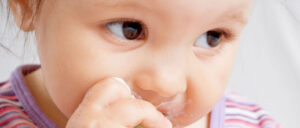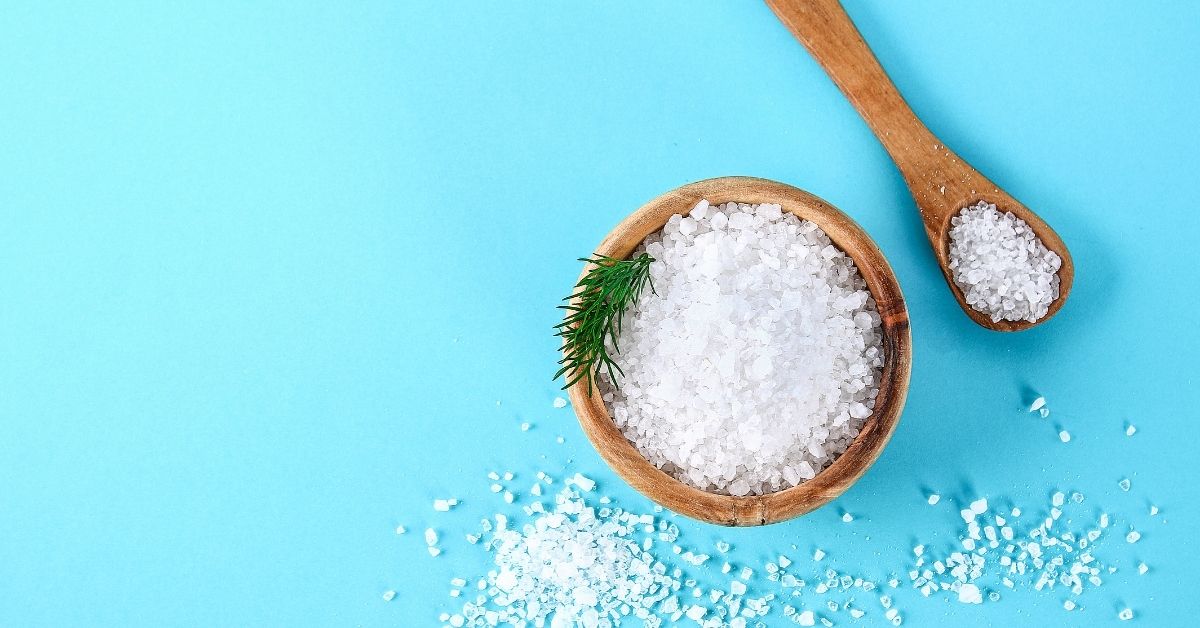INSIDE: This blog answers all your salt-related questions. When can babies have salt, how much is too much salt, lots of practical tips to keep salt intakes low, and how to read food labels?
The low salt stock cubes are in the cupboard, you make almost everything from scratch, and bacon isn’t on the weaning menu!
But you’re still worrying about where else salt might be lurking. And do you have to buy those special stock cubes indefinitely (they can be hard to track down!)
If you’re a bit confused about the messages about how much salt is OK for your baby. And when the recommendations change from no-added-salt meals to gradually relaxing the salt rules, then don’t worry.
After finishing this blog, you’ll know when babies can have salt.
Bonus: For joining my weekly newsletter, get this FREE Simple Guide to Salt and Weaning on considerately planning dinners for your toddler (and the rest of the family).

When can babies have salt? It’s all a bit confusing!
When can babies have salt?
Believe it or not, babies need some salt (or sodium) in their diet. They get salt from birth in their milk (breast or formula milk). Then, when they start solids, they will also get salt that’s naturally present in those foods. And that’s enough to meet their needs.
Why can’t babies have (too much) salt?
Salt contains sodium, and when babies have too much, their kidneys can’t cope. Another problem with giving babies salty food is that they get used to it. When they’re older, they may prefer saltier foods, which may mean more processed foods.
Evidence also suggests that early salt intake may have long-term effects on your baby’s blood pressure, even if they reduce later salt intake.
Baby-led weaning can mean higher salt intake.
Surveys show that we all eat more salt than we should. And this includes among babies during weaning. Some studies have shown that salt intakes are even higher in babies following a Baby-Led Weaning approach because parents may offer unsuitable family foods.

Baby Led Weaning Recipes need to be low salt too
What’s the maximum amount of salt my baby (toddler) should eat?
Salt for babies UNDER one year.
This is when you mustn’t offer your baby a high that’s too high in salt, as their salt requirements are low and quickly exceeded.
- Babies up to 6 months: Less than 1g salt per day (they’ll get this in their milk).
- 7-12 months: 1g salt per day (they’ll get about 0.5g from their milk and the other 0.5g from the weaning foods they eat).
Salt for babies AFTER one year
It’s still important to keep salt intakes low but this is when you can relax some of the restrictions around salt for your baby.
- 1-3 years: 2g salt per day
- 4-6 years: 3g salt per day
- 7-10 years: 5g salt per day
- Children over 11 years and adults: 6g salt per day
9 Super practical tips to keep your baby’s salt intake low during weaning
1. Don’t add salt when cooking for your baby.
Don’t add salt to your meals until AFTER you’ve removed your baby’s portion (or portions if you’re freezing some).
THEN, season for the rest of the family.
Don’t feel that your baby is missing out! They don’t know any difference and aren’t used to the taste of salted food.
How can I make my baby tasty without salt?
There’s no problem using fresh, dried or frozen herbs and spices in your baby’s meals. Just make sure to take it easy with hot spices like chilli powder.

No Salt Seasoning for Babies
2. Swap regular stock for low salt stock (or baby stock)
Regular stock cubes, stock pots and bouillon powder are incredibly high in salt. But here are two simple alternatives.
OPTION 1:
Swap regular stock cubes for low salt stock cubes suitable for babies like Piccolo, Knorr zero salt or Kallo very low salt. You can get vegetable, chicken and beef flavours. To adult taste buds these might seem tasteless, and if so, add some salt for everyone except your baby.
OPTION 2:
Use water instead of stock, and once you’ve taken out your baby’s portion, add a few spoons of Bouillon powder or a jelly stockpot for the rest of the family.
3. Hold the salty ingredients in your baby’s food.
Some recipes use soya sauce, fish sauce or Worcestershire sauce to add flavour. Leave them out until you’ve taken out your baby’s share.
4. Choose unsalted and unprocessed meat, fish and other protein foods.
This means avoiding ham (yes, even home-cooked ham!), rashers, sausages, chorizo and shop-bought processed products like nuggets and burgers, whether meat or plant-based. Smoked fish is also high in salt, so avoid that, too.
Instead, choose plain meat, chicken, beans, lentils, tofu or fish and cook these yourself without salt. But feel free to add any herbs and spices that you like.
5. Don’t introduce salty snacks for babies
You don’t need to read the food label to know that crisps and many types of crackers, like Tuc crackers, are high in salt. Your baby doesn’t need snacks. And you certainly don’t need to fill up on these salty foods, so don’t introduce them. If you need to offer your baby a snack, offer a mini-meal of the same foods you’d offer at main meals.
READ MORE: Food for your 7-month-old: Feeding Schedule
6. Hold the butter
Butter is lovely BECAUSE it’s so salty. Either choose oil for cooking and baking (rapeseed oil is a flavourless oil perfect for pancakes and muffins) or unsalted butter or lower salt spreads.
7. Don’t use gravy to wet your baby’s food.
Have you ever seen a ‘baby bowl’ on a restaurant menu?
For those of you that haven’t, they’re usually an enormous bowl of mushed-up potatoes and vegetables mixed with soup or gravy. And neither soup nor gravy is suitable for babies. Unless it’s homemade gravy or soup using zero salt stock.
Instead of using gravy or soup to moisten your baby’s food, try yoghurt or some cooking water. Or make and freeze your low-salt soup or gravy (if you do this fair play, I never did!).
8. Swap shop-bought sauces for simple homemade versions
Jars of sauce can be high in salt. But you can quickly transform chopped tinned tomatoes, unflavoured passata (because sometimes the flavoured versions contain more salt) and tomato purée into sauces for pasta, pizza, stews and casseroles.
Here are some essential sauce recipes you can make at home:
Tomato sauce (leave out the sugar)
White sauce (use unsalted butter)
9. Choose low-salt breakfast cereals suitable for babies
Many breakfast cereals contain quite a bit of hidden salt. The good news is that everyday cereals like porridge, Ready Brek and Weetabix and their brand alternatives are very low in salt and perfect for your baby’s breakfast.

Learning to understand food labels is important
How do you know if packaged food is too high in salt for your baby?
While it’s easy to stay in control of the food you make at home, a lot of salt comes from hidden sources. It’s essential to understand how to read food labels and identify whether foods are high or low in salt for your baby.
EU legislation ensures that the salt content of foods marketed to babies is kept at low levels. But if you’re choosing regular packaged foods, ensuring your baby’s salt content is safe is essential.
Ready, Steady, Wean-From Confused To Confident In No Time At All
Save yourself time, stress and money and get all the answers you need in one easy-to-follow online course.

Here’s what you’re looking for on the label:
A quick guide from The Irish Heart Foundation on comparing foods with high or low salt is to see how many grams of salt the product contains per 100 grams.
- HIGH = over 1.5 grams
- MEDIUM = 0.3 grams to 1.5 grams
- LOW = 0.3 grams and under
Sometimes, labels state the amount of sodium instead of salt. To calculate the amount of salt, multiply the sodium figure by 2.5. For example, if a food has 1 gram of sodium per 100g, it has 2.5 grams of salt!
- Low salt – no more than 0.3g of salt per 100g or 100ml
- Very low salt – no more than 0.1g of salt per 100g or 100ml
- Salt-free – no more than 0.0125g of salt per 100g or 100ml
- Reduced salt or Light/lite in salt – compared with the standard version, at least 25 per cent less salt per 100g or 100ml
- No added salt – does not contain any added salt and contains no more than 0.3g of salt per 100g or 100ml
LEARN MORE >>> How to guide on meal planning for the family
Choose brands with the least amount of salt
The salt content of the same product varies hugely from brand to brand. And parents ask me ALL the time for brand recommendations. But because manufacturers change their ingredients, it’s best to compare these yourself where YOU shop. Then, choose the brand with the least salt for the food you want to buy.
Here are a few examples to show you HOW much the salt content varies between brands for the same food: (salt intake per 100g).
| Food | Aldi | Tesco | Branded |
| Baked beans | 0.39g | 0.5g | 0.8g* |
| Hummus | 0.65g | 0.9g | 1.58g ** |
| Curry Powder | 12.3g | 8.2g | 14.2g *** |
*Bachelor’s
**The Happy Pear
*** Schwartz (most curry powders contain added salt, but consider how much you’re using in the context of the overall dish; it’s usually only a minimal amount. for example, a tablespoon of Aldi curry powder contains x, and this will serve four adults!).
You can see that it’s not always safe to assume that the more expensive branded products are the lowest in salt. However, these are only a few examples; there might be others where the branded product is lower in salt. It’s worth checking yourself!

Parents are often concerned about their baby eating cheese
When can babies eat these foods that contain salt?
Some foods like cheese, tinned fish and bread are nutritious foods to include in the weaning diet even though they are relatively high in salt. Because they offer nutrients like calcium (cheese), omega-three oils (fish) and B vitamins (bread). And because they’re everyday family foods.

Once your baby turns one you can relax the salt rules a little
Does cheese have too much salt for babies?
Cheese contains added salt, but exactly how much depends on the type. Cheeses that contain lower amounts of salt include Emmental, cream cheese and mozzarella (0.5 g per 100g). Cheddar and parmesan contain more (1.8g per 100g), and Feta and Halloumi are the saltiest (3g per 100g).
You can offer your baby any kind of cheese but aim to choose lower salt styles more often. And there’s no need to offer cheese every day. Make sure to leave space in your baby’s diet for various foods.
Choosing a low-salt bread for your baby
- ALL bread contains salt. However, if you’re making your bread, you can leave it out. But realistically, most parents don’t have the time, skill or inclination to make bread! And that’s fine.
- Most shop-bought bread contains about 1g of salt per 100g. Some have a little more, and some a little less. Some ‘healthy seeded bread’ may contain considerably less. However, these ‘healthy’ breads aren’t always suitable for babies because they have big seeds that are a choking hazard. But if you can find bread with low salt content and tiny seeds like chia, go for it!
- It’s also worth noting that some Artisan bread contains considerably more salt. It’s why it tastes so lovely!
- So, bread is acceptable, but choose the one on the shelf with the least salt. And don’t be overly reliant on bread at mealtimes. Vary your baby’s diet between bread, pasta, potatoes, homemade pancakes, muffins, rice and suitable cereals.
What about tinned fish?
Tinned oily fish like salmon, sardines, and mackerel is a handy store cupboard ingredient for quick and easy meals for your baby. And it’s OK to offer once or twice a week.
In one famous brand of sardines I checked (John West!), each tin contained 1g salt per 100g, regardless of whether it was tinned in oil, brine or tomato sauce.
READ MORE: Baby meal ideas you can make from your cupboard
When my baby is over one, can they have salt then?
This is something that my parents ask me ALL the time.
Toddlers can safely eat more salt than babies, but it’s still important to limit salt and salty foods (FSAI 2020). So, following most of the guidelines as you would for babies under one makes sense. But generally, it’s OK to make your family meals using regular stock and to use ingredients like soya sauce, etc. Also, occasionally, using some commercially available sauces is fine.
The bottom line on when babies can have salt
For babies under one year, offer a variety of fresh home-cooked foods with no added salt. The occasional shop-bought product is fine if it is not a ‘high salt’ food. Aim to offer a variety of food to your baby, and don’t be overly reliant on higher salt options like cheese and bread. Once your baby turns one you can relax on some of the salt restrictions but still aim to keep added salt to a minimum.
Get Your Simple Salt and Weaning Guide
When you’re dealing with the overwhelm of weaning information it’s handy just to have some simple guidelines to follow. That’s why I created this simple FREE guide to salt and weaning.
- Get my Simple Salt and Weaning Guide. You’ll get the guide, plus join my weekly newsletter! Just click here to get it and subscribe.
- Print or download it onto your phone.
- Hang your Guide somewhere handy, like the fridge. Or save it in a folder on your phone.
Ready, Steady, Wean-From Confused To Confident In No Time At All
Save yourself time, stress and money and get all the answers you need in one easy-to-follow online course.

The Tricky Third Meal-Quick and Easy Baby Lunch Ideas
Are you struggling with what to serve your baby at lunchtime? If so, you're not alone! You won't be for long. This blog has tonnes of quick and easy baby lunch ideas for you. When do I start offering my baby three meals a day? While...
Five perfect first foods (including baby rice)
Which is the best first food for your baby. Is it baby rice, green veggies or peanut butter? I'll share the pros and cons of 5 of the most common choices. What is the best first food for your baby? So, you know your baby’s ready to start...
A guide on meal planning for the family
28, 000 is roughly the number of meals you'll prepare for your child! Meal planning can help ease the burden. We know family meals are important but that doesn't mean it's easy to get dinner on the table every night. Especially when you're...










0 Comments